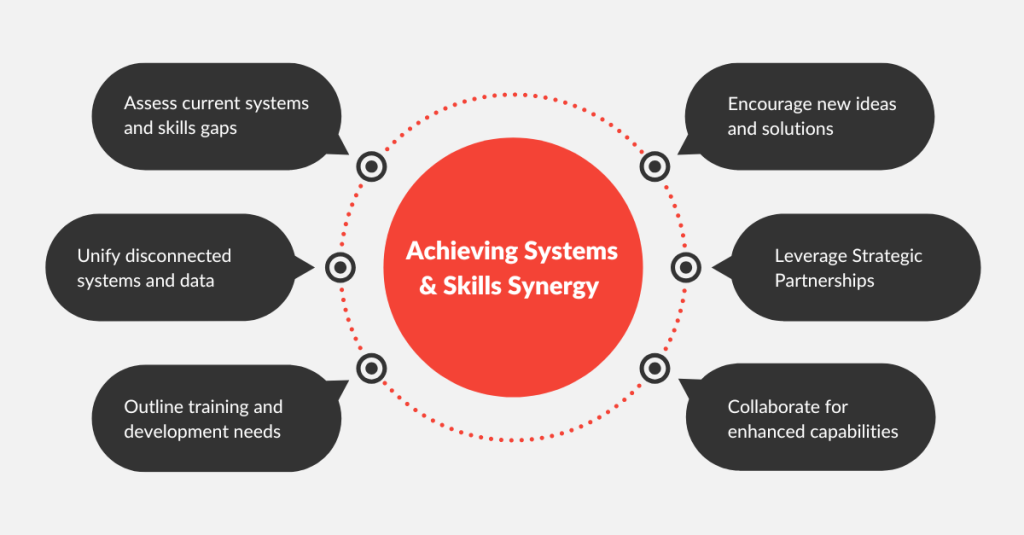Artificial Intelligence and Automation have brought about significant change in the Business scenario, offering unparalleled opportunities for optimization, innovation and competitive advantage. However, simply adopting these tools is not enough – businesses need a strategic roadmap to integrate intelligent automation in a way that transforms their operations.
This guide provides that critical roadmap. By following the five essential steps, you will be able to chart your unique course to successfully leverage AI and automation. We will explore how to assess your current processes, identify automation opportunities, evaluate available solutions, pilot promising technologies, and scale adoption across your organization.

It’s anticipated that 65% of organizations utilizing automation technologies will expand their capabilities to include artificial intelligence (AI) technologies such as machine learning (ML), natural language processing (NLP), as well as process and task mining, alongside intelligent document processing (IDP). This also emphasizes how AI-enabled Automation is consistently becoming critical to stay ahead in the competition.
I. Simplify and Prioritize: The Foundation of AI Automation
In the quest to access AI automation, the initial step for business leaders is not to plunge into the vast sea of technological options but to strategically streamline and prioritize internal processes. This foundational move is akin to preparing the soil before sowing seeds of innovation—essential for ensuring the growth of robust and fruitful outcomes.
Simplification of the processes
The complexity of modern business operations often masks inefficiencies and redundancies that can dilute the impact of AI automation. The art of simplification begins with a meticulous audit of existing processes to identify bottlenecks, redundancies, and non-value-adding activities.
Simplification not only makes processes more efficient but also more amenable to automation. It involves asking critical questions: Which steps can be eliminated? Can multiple steps be consolidated into one? This exercise is not about cutting corners but about achieving elegance in operation, where every activity serves a purpose, and nothing is superfluous.
Identifying High-Value Areas
The next stride in this journey involves pinpointing processes that, when automated, will significantly move the needle for the business. It’s about discerning the strategic from the merely operational, focusing on areas that offer substantial business value. High-value areas typically exhibit one or more of the following characteristics: high volume, prone to error, critical for customer satisfaction, or strategically aligned with long-term business goals. Here’s a detailed guide for Identifying Opportunities and where AI Automation can make a difference.
A Framework for Assessment and Prioritization
To effectively assess and prioritize processes for automation, business leaders can employ a simple yet powerful framework: Impact, Feasibility, and Strategic Alignment (IFSA). Impact measures the potential benefits in terms of efficiency, cost savings, and customer satisfaction. Feasibility evaluates the technical and operational readiness for automation. Strategic Alignment ensures that the automation efforts are in sync with the organization’s goals and vision.
II. Bridging Gaps: Systems Alignment and Skills Enhancement
As business leaders explore the journey of integrating AI automation, navigating the landscape requires more than just a map of where to go—it demands a keen understanding of the terrain and the readiness of the team to traverse it.
Navigating System Disparities
Identifying system disparities becomes critical, requiring leaders to assess their technological landscape for compatibility, connectivity, and scalability issues. Aligning these systems involves evaluating current IT infrastructure, identifying bottlenecks, and investing in upgrades or integrations that facilitate a unified automation framework. Also, when planning to integrate AI automation, look for a solution that can be integrated with your existing systems with very low infrastructure requirements.
Strategies for Systems and Skills Synergy
Achieving synergy between systems alignment and workforce enhancement requires a dual-focused strategy. Here are a few actionable steps for business leaders:

III. Strategic Investment in End-to-End AI Automation
In the digital economy, where agility and responsiveness are paramount, the ability to automate processes from start to finish becomes a critical competitive edge. End-to-end automation not only streamlines operations but also enhances decision-making, customer experiences, and business agility. The investment in such technologies is strategic because it goes beyond the mere automation of tasks—it transforms the very fabric of how a business operates and delivers value. Here’s a blog to understand how to identify which processes are the right candidate for AI Automation.
IV. Integration Preparedness: Equipping Systems and People for AI Automation
The path to AI automation is as much about technology as it is about people. For businesses poised to start on this journey, achieving integration preparedness is pivotal. It’s a dual endeavor that involves not only equipping systems for seamless AI automation integration but also cultivating an organizational culture that embraces the winds of AI-driven change.
Cultivating Technical Readiness
Here’s how business leaders can pave the way for technical preparedness:
Audit and Upgrade IT Infrastructure
Begin with a thorough audit of your existing IT landscape. Identify potential bottlenecks and areas that require upgrades or modernization to accommodate tools along with your chosen AI Automation partner.
- Ensure Data Quality and Accessibility: AI-Automation systems thrive on data. Ensure your data management practices are up to the mark, with a focus on data quality, integrity, and accessibility.
- Adopt Scalable Architectures: Embrace architectures that are inherently scalable and flexible, such as microservices or containerization. This allows for the seamless integration of AI applications and facilitates the agile deployment of new features or updates.
- Foster Technical Agility: Encourage an IT culture that is agile, experimentative, and open to adopting emerging technologies.
Nurturing Cultural Readiness
While technical readiness sets the stage, cultural readiness ensures that the curtain rises to widespread acceptance and enthusiasm for AI automation. Cultivating an organizational culture that is conducive to AI-driven change involves:

For business leaders, achieving integration preparedness for AI automation is a journey that requires proper planning, robust infrastructure, and a forward-thinking culture. By addressing both technical and cultural readiness, organizations can not only navigate the complexities of AI integration but also harness its full potential to drive unparalleled innovation, efficiency, and growth.
V. Cultivating AI Talent and Fostering Strategic Thinking
As routine tasks become automated, the workforce is freed to tackle more complex, high-level tasks that demand creativity, critical thinking, and strategic insight.
Creating a thriving AI ecosystem within an organization means:
- Tailored Learning Pathways: Implement personalized learning for AI and automation skills, from basic understanding to advanced technical abilities, through online courses and workshops.
- Mentorship and Collaboration: Connect AI experts with novices for knowledge transfer and encourage cross-departmental collaboration to fuel innovation and demystify AI.
- Real-world Application: Provide opportunities for employees to deploy their AI skills in real-world projects, enhancing learning and showcasing AI’s business impact.
Enhancing Strategic Skills
With AI handling routine operations, emphasizing critical thinking and strategic planning becomes crucial.
- Problem-Solving Workshops: Host workshops that challenge employees with complex, cross-departmental problems, fostering critical thinking and a broad understanding of business challenges.
- Strategic Planning Exercises: Involve employees in strategic exercises like scenario planning, enhancing their ability to anticipate trends and formulate proactive strategies.
- Cross-Functional Projects: Promote involvement in projects that require teamwork and strategic decision-making, enriching business understanding and strategic contribution.
- Leadership Development: Offer programs in innovation management and strategic leadership to prepare future leaders for navigating AI automation challenges and opportunities.
- Cultivate Curiosity: Encourage a culture where questioning, exploring new ideas, and challenging norms are celebrated, fostering innovation and competitive edge.
This streamlined approach to AI talent development and strategic skill enhancement prepares organizations to thrive in an AI-driven future, leveraging technology for creative and strategic business advantages.
The journey towards AI automation represents not just a technological upgrade but a strategic evolution for businesses across the globe. Through the exploration of the top five priorities for AI automation—Streamlining and Prioritizing, Bridging Gaps, Strategic Investment, Integration Preparedness, and Cultivating Talent and Strategic Thinking—we’ve unveiled a roadmap that promises to guide organizations towards a future where AI is not merely an adjunct but a core driver of innovation, efficiency, and competitive advantage.
The importance of each of the steps in the plan cannot be overstated. The journey towards AI automation is both exciting and challenging. By following these steps businesses can ensure they are not only prepared for the future but are actively shaping it. The time to act is now—forge ahead with confidence, knowing that with the right approach, the possibilities are limitless. Let’s embark on this strategic journey together, harnessing the power of AI-Automation to unlock new levels of success and innovation.




